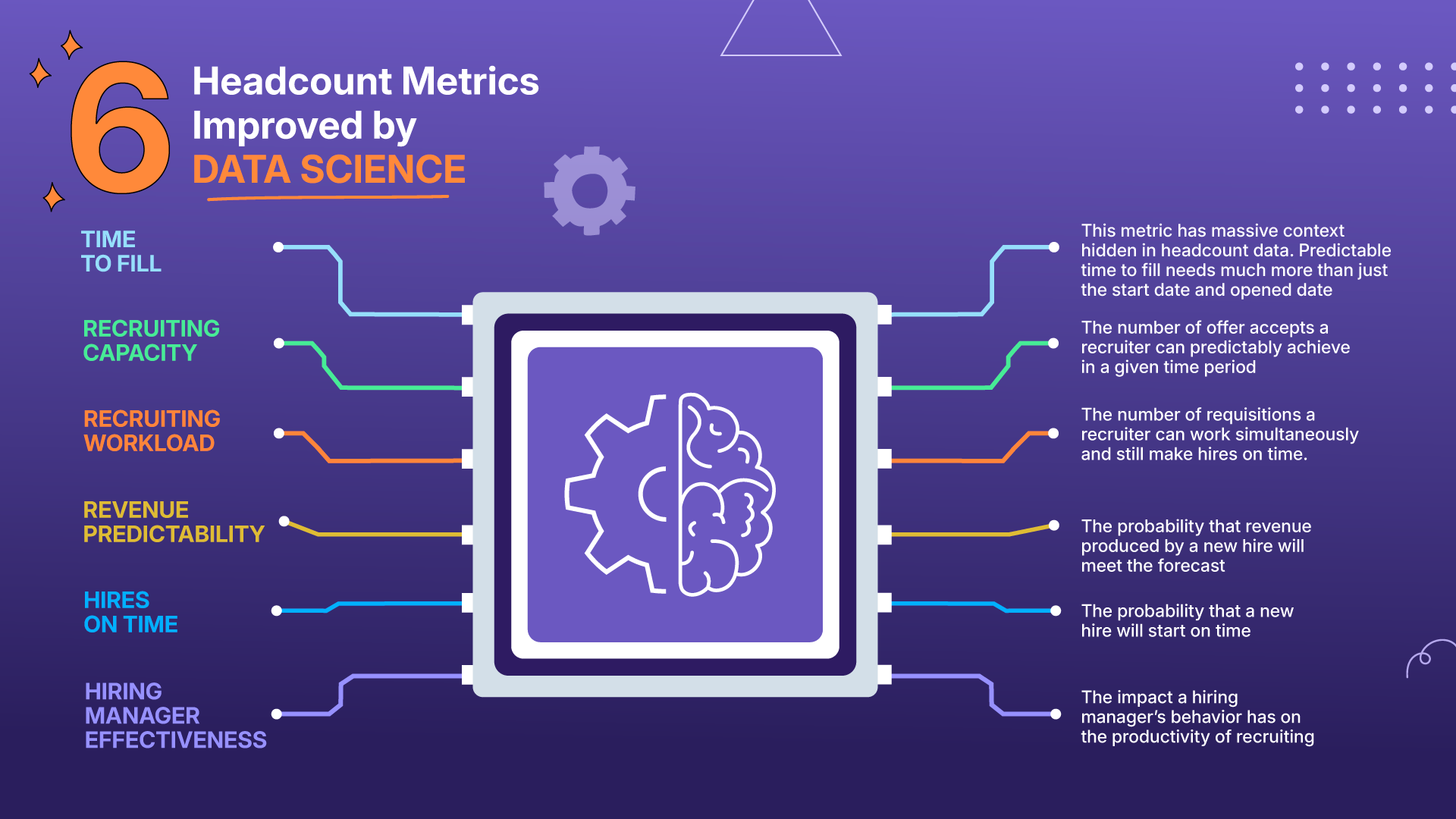6 Headcount Metrics Improved by Data Science
Table of Contents
Headcount365 is the first time In the realm of talent acquisition and management, accurate metrics are crucial for making informed decisions. Traditional manual tracking methods can be cumbersome and prone to errors, while data science offers precise, efficient, and actionable insights. Here are six key headcount metrics that can be significantly improved through data science:
Time to fill
Data science makes time to fill more predictable by analyzing historical hiring trends, recruiter performance, and role-specific data to forecast how long it will take to fill a position. By reducing guesswork and minimizing human error, it helps talent leaders create more reliable timelines, leading to faster, more efficient hiring processes and fewer delays.
Why Manual Tracking is Sub-Optimal: Manual tracking of time to fill often relies on basic calculations from start to end dates, missing out on the complexities and variables influencing this metric. It doesn't account for different stages of the hiring process, candidate drop-off rates, or recruiter performance.
How Data Science Improves Accuracy: Data science leverages advanced algorithms and predictive analytics to analyze historical data and identify patterns. By incorporating variables like industry benchmarks, job complexity, and seasonal trends, data science can predict more accurate time-to-fill metrics. Machine learning models can continuously learn from new data, refining predictions and providing deeper insights into bottlenecks in the hiring process.
Recruiting capacity
With data science, recruiting capacity is easier to forecast by analyzing recruiter workloads, candidate flow, and industry benchmarks. This allows recruiting leaders to optimize their team’s performance and allocate resources more efficiently, reducing bottlenecks and ensuring the team can meet hiring demands consistently.
Why Manual Tracking is Sub-Optimal: Estimating recruiting capacity manually often leads to over or underestimation, as it fails to consider the varying complexities of different roles and fluctuating recruiter workloads. It also doesn't dynamically adjust to changes in recruiter efficiency or market conditions.
How Data Science Improves Accuracy: Data science utilizes historical data, recruiter performance metrics, and market trends to build models that predict recruiting capacity more accurately. These models can factor in the complexity of job roles, historical recruiter performance, and external market conditions to provide a dynamic and realistic estimate of how many offers a recruiter can handle within a given period.
Recruiting workload
Data science helps manage recruiting workload by identifying trends in requisition volume and predicting peak periods. This insight allows talent leaders to balance workloads across the team more effectively, reducing burnout and improving overall recruiting efficiency.
Why Manual Tracking is Sub-Optimal: Manual methods often generalize recruiter workload without considering the specific demands of each requisition. This approach can lead to burnout or underutilization of recruiters, negatively affecting hiring outcomes.
How Data Science Improves Accuracy: With data science, predictive models can analyze the workload of recruiters by considering the complexity, volume, and historical fill rates of different roles. These models can recommend optimal workload distributions, ensuring recruiters are neither overburdened nor underutilized. This leads to improved efficiency and better hiring outcomes.
Revenue predictability
Data science can link hiring data to revenue outcomes, giving finance teams a clearer understanding of how headcount impacts revenue generation. By predicting how new hires will contribute to financial performance, it enables more accurate forecasts, allowing businesses to make strategic hiring decisions that drive growth.
Why Manual Tracking is Sub-Optimal: Manually predicting revenue contributions from new hires is challenging due to the numerous variables involved, including the quality of hires, ramp-up time, and alignment with business goals. This method often relies on static assumptions and lacks the nuance of real-time data.
How Data Science Improves Accuracy: Data science can integrate various data sources, including historical performance data, market trends, and individual hire profiles, to predict the revenue impact of new hires accurately. Advanced analytics can simulate different scenarios and provide probability-based forecasts, helping businesses align their hiring strategies with revenue goals.
Hires on time
By using predictive analytics, data science helps ensure that hires are made on time by identifying potential delays in the recruiting process. With better visibility into where roadblocks occur, talent leaders can proactively resolve issues, making the entire hiring process more streamlined and timely
Why Manual Tracking is Sub-Optimal: Tracking whether hires start on time manually can be inconsistent and often fails to account for delays caused by multiple factors such as background checks, relocation issues, or contractual negotiations.
How Data Science Improves Accuracy: Predictive analytics models can analyze historical data to identify patterns and factors that cause delays. By monitoring these variables in real-time, data science can provide alerts and recommendations to ensure that potential delays are addressed promptly, increasing the probability of hires starting on time.
Hiring manager recruiting ability
headcount365’s 3 system connections combines 3 sets of data previously unavailable in one reporting tool to track the behaviors that impact hiring in an objective way.
Why Manual Tracking is Sub-Optimal: Evaluating hiring manager effectiveness manually can be subjective and inconsistent, often relying on anecdotal feedback rather than objective data.
How Data Science Improves Accuracy: Data science uses performance metrics, such as time taken to fill roles, feedback completion rates, and interview outcomes, to objectively assess the impact of hiring managers on the recruitment process. By analyzing this data, predictive models can identify areas for improvement and recommend training or adjustments to improve overall recruitment efficiency.
Conclusion
Incorporating data science into talent acquisition processes transforms how headcount metrics are tracked and analyzed. By moving beyond manual methods, organizations can achieve greater accuracy, efficiency, and strategic alignment in their recruitment efforts, ultimately leading to better hiring outcomes and a more robust financial performance.


